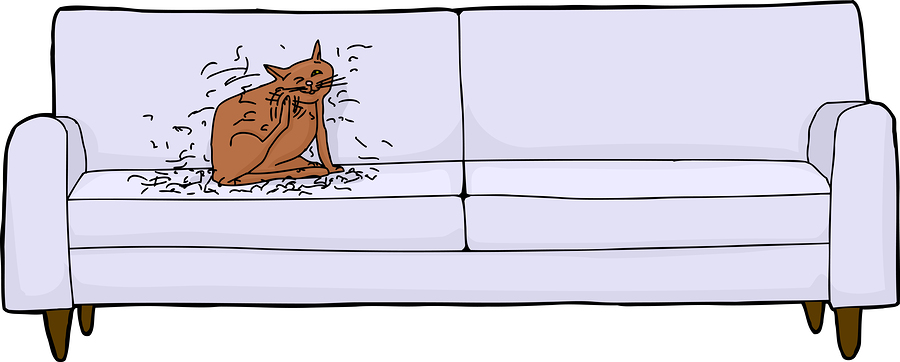This post may contain affiliate links. We are compensated for referring customers to our affiliate partners.
Cats are one of the most popular pets in the world. They are funny, independent, serene, and not a little bit crazy at times. All off these traits and emotions wrapped up into one pet makes for an exciting adventure! Some people love to snuggle with these fluffy balls of fur, while some prefer their cats to be less on the fuzzy side. Let’s face it, no one really loves cat hair sticking to the seat of their pants, floating through the air when Felix goes on a scratching spree, or sitting atop your cupcake after Miss Kitty spent the afternoon watching you bake; up close. Though there are many people who take the fur with the good and buy stock in lint rollers, some might not be ready for such mess.
Shedding And The Allergy Problem
When it comes to hair loss, it might be more than just a matter of aesthetics to some people. Allergies can be a major issue when it comes to adding a new cat to your home. Shedding can produce dander and allergens that can make some people’s eyes water and nose run. Does this mean that a cat is out of the question? It depends on the shedding. You might be thinking, “All cats shed though, right?” The truth is, it isn’t quite that simple. While the mass majority of cats do shed fur at times, not all cats shed the same amount. Plus, there are hairless breeds that don’t shed at all because they have nothing to shed. If you are trying to decide what breed of cat is best for you and your family and you feel strongly about pet hair, there are a few breeds that you should consider before making your final decision.
The Less-Sheddy Breeds Might Be Just What You Need
These are breeds that are the least sheddy of all the shedders and might be just what you need to make your house a loving feline home.
Cutting right to the chase, we give you the Sphynx. This is the cat most often referred to when people talk about a hairless variety. If you have ever watched the “Austin Powers” movies, you have seen the hairless cat Mr. Bigglesworth who was a Sphynx. Though this may seem like a hairless wonder, the Sphynx actually has some hair; it is very sparse and short. Due to the lack of heat retaining and oil-absorbing hair, they are cold sensitive and need regular bathing to stay clean.
Similar to the Sphynx are two other near-hairless breeds; the Donskoy and the Peterbald. The Donskoy has a high body temperature that keeps him from being cold-sensitive and this cat actually sweats like a human. The Peterbald is as close to hairless as one can get; nearly bald or with a very short velvety coat.
The Cornish Rex and the Devon Rex. These kitties do have a coats, but they are much more sparse and short than other cats. In fact, their coats lacks the guard hairs found on most breeds which leaves them with only the wavy down hairs. They look and feel soft and silky without leaving their hairs on your sofa. Though they are both low-shed, the Devon Rex sheds even less than the Cornish.
Don’t let the long coat fool you; the Javanese cat sheds 2/3 less than other cats. The long coat is made up of only long guard hairs without the down or awn hairs that can cause shedding. This way, you get all of the fluffy cuddles without having to bring out the dust buster.
Finally, if you want a big snuggly cat with minimal shedding, the Siberian might be the one for you. The coat is long and luxurious with a dense undercoat. But instead of shedding out all over your house, these hairs get caught in the guard and awn hair where they stay put until you brush them out. As long as you don’t mind grooming regularly, you can have the best of both worlds with the Siberian.
A Cat Food Analysis For Your Low Shed Breeds
Cat food does play a part in how much your kitty sheds. Two very important nutrients are protein and fat.
Protein comes from meat-based sources and can give your cat exactly what she would eat if she were in the wild: meat. Since cats are obligate carnivores, they need more protein in their diets than other species do. When they lack the proper amount of protein in their diets, their coats can suffer as hair is made from keratin, which is a protein. When doing a cat food analysis, look for brands that list the first ingredient or two as animal-based protein. Some good examples would be:
- Orijen Regional Red
- Blue Wilderness Adult Chicken
- The Honest Kitchen Grain Free Turkey
Fat is just as important when it comes to decreasing shedding. A cat food analysis shows that omega-3 and omega-6 fatty acids are essential for the development of healthy skin and fur on your cat. Fish and fish oils on the ingredient list are also good for your cat’s coat and even flax and flax oil can contribute to good health. Some good examples would be:
- By Nature Adult Dry
- Solid Gold Katz-n-Flocken
- Wellness Complete Health Chicken Recipe
The Best You Can Give
A cat in your home is worth more than you can imagine. For the love and comfort they give, be sure that you are doing right by them by providing the best nutritionally sound cat food possible. Hair or no hair, the health benefits will last a lifetime.



